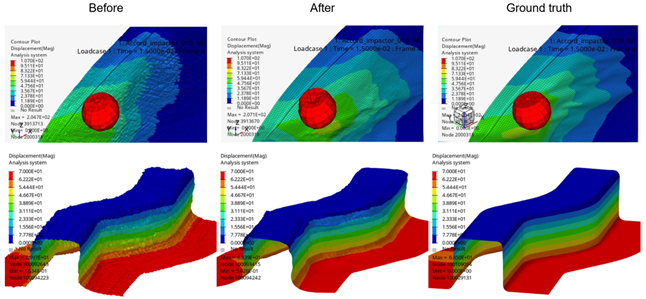PhysicsAI
Announcements
License checkout for training, testing, and prediction will now draw 75 Altair Units.
New Features
- Improved Predictions of Contours
- Although numerically insignificant, physicsAI could produce animations
with localized noise; the effect was most notable in deformation
animations. A new smoothing scheme is being introduced to produce
cleaner output predictions. The improved algorithm improves predictions
by both reducing noise and improving accuracy.
Figure 1. 
- Enhanced Insights for Model Quality Assessment
- After training, data scientists rely on numerical metrics to evaluate the accuracy of the machine learning model. New metrics include coefficient of determination (r-squared), Sprague-Geers, and absolute and percent errors of the peak values. The new metrics add to physicsAI’s broad range diagnostic tools used to appraise model quality.
- Access Scalable Computing Resources with Seamless Integration to Altair One
- Geometric deep learning requires substantial computing resources for training. For projects saved on Altair One Drive, training can be submitted to Altair One's HPC system with a single click. Access to the computing power you need is easy with Altair One’s scalable HPC and cloud resources.
Enhancements
- Batch size is exposed as a training parameter.
- The number of nodes and elements present in each file of the dataset is visible for review.
- Improved error messages.
Resolved Issues
- MAE predictions improperly ignored contributions from entities with a truth of zero.
- Vector predictions produced poor results if the output values were very large or very small.
Known Issues
- Sorting columns in the training tables are not correct for scientific notation.
- Backwards compatibility with specification files created in 2022.3 is ending. New files should be created.